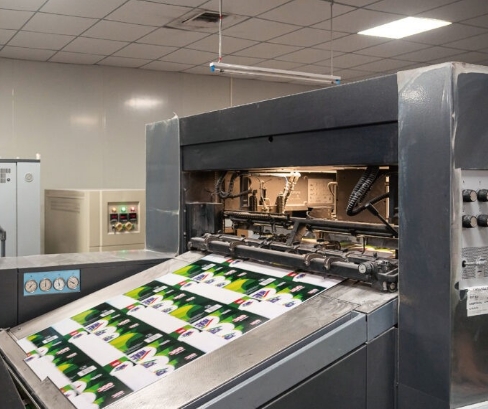How to Achieve Color Consistency in Printed Materials
In the print marketing, color consistency stands as a cornerstone of success. Whether it’s a brand logo on a business card or a vibrant brochure showcasing products, maintaining uniformity in color across printed materials is crucial for brand identity, consumer trust, and overall visual appeal. In this article, we’ll explore the importance of color consistency in printed materials, the challenges associated with achieving it, and discuss effective strategies for maintaining uniformity.

The Significance of Color Consistency in Printed Materials
1. Brand Identity Reinforcement
Recognition: Consistent colors serve as a key element in brand recognition. When consumers encounter consistent colors across different printed materials, such as business cards, brochures, and packaging, they quickly associate those colors with the brand, reinforcing brand identity and recall.
Professionalism: Inconsistencies in color can detract from the professional appearance of printed materials. Maintaining color consistency conveys attention to detail, professionalism, and a commitment to quality, enhancing brand credibility and trustworthiness.
2. Effective Communication
Message Clarity: Consistent colors help ensure that the intended message of the printed material is conveyed accurately. Whether it’s a call-to-action on a flyer or product information on a label, uniform colors make the content more legible and comprehensible, improving communication effectiveness.
Visual Cohesion: Uniform colors create visual harmony and cohesion across different printed assets. This cohesion enhances the overall visual appeal of marketing materials, making them more engaging and memorable to the audience.
3. Customer Experience Enhancement
Consistency Expectation: In today’s competitive market, consumers expect consistency from brands across all touchpoints, including printed materials. Consistent colors instill confidence in consumers, signaling reliability and attention to detail, which positively impacts the overall customer experience.
Brand Trust: Inaccurate colors or inconsistencies in printed materials can undermine brand trust and perception. By ensuring color consistency, brands demonstrate their commitment to delivering high-quality products and services, fostering trust and loyalty among consumers.
4. Operational Efficiency
Streamlined Production: Color consistency streamlines the production process for print service providers. By establishing standardized color profiles and workflows, printers can minimize color adjustments and reprints, leading to greater efficiency and cost savings.
Reduced Waste: Consistent colors reduce the likelihood of color-related errors and rejections during the printing process. This minimizes waste of materials, time, and resources, contributing to a more sustainable and environmentally friendly printing operation.

Challenges in Achieving Color Consistency in Printed Materials
Achieving color consistency in printed materials is a complex process that involves various challenges stemming from both technical and environmental factors.
1. Printer Variation:
- Hardware Differences: Different printing devices, even of the same model, may produce slight variations in color output due to differences in hardware components, such as print heads and ink delivery systems.
- Calibration Discrepancies: Inconsistent calibration settings among printers can lead to variations in color reproduction. Factors such as ink density, color profiles, and resolution settings may differ from one printer to another.
2. Substrate Influence
- Paper Type and Texture: Different types of paper and printing substrates absorb ink differently, leading to variations in color appearance. Factors such as paper texture, coating, and opacity can affect ink absorption and reflectance, resulting in color shifts.
- Ink Absorption: Highly absorbent substrates may cause inks to spread and blend, resulting in less vibrant colors and reduced color accuracy.
3. Environmental Factors
- Temperature and Humidity: Fluctuations in temperature and humidity in the printing environment can impact color perception and print quality. Changes in environmental conditions may affect ink drying times, paper expansion or contraction, and color stability.
- Lighting Conditions: Inconsistent lighting conditions in the printing facility can affect color perception and evaluation. Different lighting sources, such as natural daylight, fluorescent, or LED lighting, may alter color appearance and visibility.
4. Ink and Color Management
- Ink Formulation: Variations in ink formulation, viscosity, and pigment concentration can impact color consistency. Differences in ink batches or suppliers may result in color variations between printing jobs.
- Color Management Practices: Inadequate color management practices, such as outdated color profiles, improper calibration, and inconsistent color workflows, can lead to color discrepancies and inaccuracies.

5. Human Error
- Manual Color Adjustments: Human intervention in color adjustments during the printing process can introduce errors and inconsistencies. Improper adjustments to color settings, such as hue, saturation, and brightness, may result in unintended color shifts.
- Communication Challenges: Miscommunication between designers, print operators, and clients regarding color expectations and requirements can lead to discrepancies in color reproduction.
Effective Strategies for Achieving Color Consistency in Printed Materials
Achieving color consistency in printed materials requires a systematic approach that addresses various technical, environmental, and operational factors.
1. Standardized Color Management System
- Color Profiling: Use color management software to create accurate color profiles for printers, monitors, and substrates. Calibrate and update these profiles regularly to maintain consistency.
- Color Standards: Adhere to industry-standard color spaces, such as CMYK or Pantone, to ensure consistency across different printing devices and substrates.
- Device Calibration: Regularly calibrate printing devices, including printers, monitors, and spectrophotometers, to ensure accurate color reproduction.
2. Quality Control Procedures
- Color Verification: Conduct color verification checks throughout the printing process using color measurement devices, such as spectrophotometers, colorimeters, visual printing inspection machine, etc. Compare printed samples against reference standards to detect any color variations.
- Test Prints: Perform test prints on different substrates and under various environmental conditions to evaluate color accuracy and consistency before running full production.

3. Substrate Selection and Preparation
- Consistent Substrates: Use consistent printing substrates, such as paper stock or packaging materials, to minimize variations in color appearance. Select substrates with uniform characteristics, such as texture and coating, to ensure consistent ink absorption and reflectance.
- Pre-Press Treatment: Properly prepare substrates before printing by ensuring they are clean, dry, and free from contaminants that may affect color reproduction.
4. Environmental Control
- Stable Printing Environment: Maintain stable environmental conditions in the printing facility, including temperature, humidity, and lighting. Minimize fluctuations in environmental factors to ensure consistent color reproduction.
- Lighting Considerations: Use consistent lighting conditions, such as neutral white light, in the printing area to minimize color shifts and ensure accurate color perception.
5. Color Communication and Collaboration
- Clear Communication: Establish clear communication channels between designers, print operators, and clients regarding color expectations and requirements. Provide detailed color specifications, including color swatches or reference samples, to ensure alignment.
- Collaborative Approaches: Foster collaboration between stakeholders involved in the printing process to address color-related challenges and optimize color reproduction.
6. Continuous Improvement
- Feedback Mechanisms: Solicit feedback from clients and internal stakeholders on color accuracy and consistency. Use feedback to identify areas for improvement and implement corrective actions as needed.
- Training and Education: Provide ongoing training and education for print operators and staff on color management best practices, techniques, and tools.
Conclusion
Color consistency in printed materials is not just a matter of aesthetics and it’s a reflection of brand identity, professionalism, and attention to detail. By prioritizing color management, implementing standardized procedures, and fostering collaboration, printers can ensure that every printed piece reflects the intended brand identity and message accurately. Consistency breeds trust, credibility, and visual harmony, ultimately driving success in the competitive landscape of print marketing.

